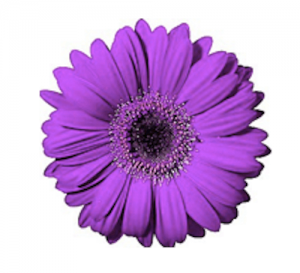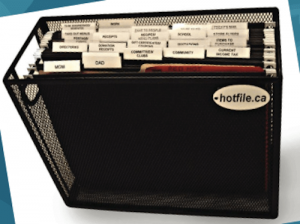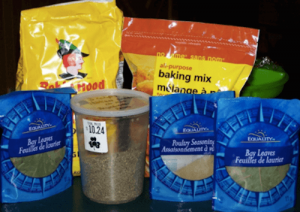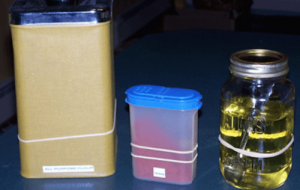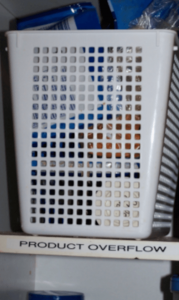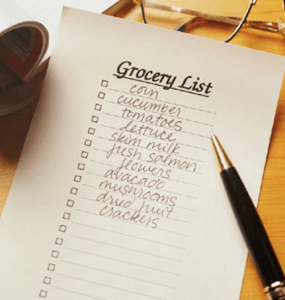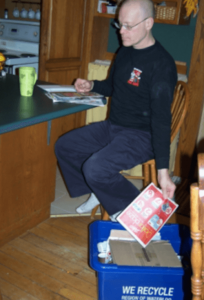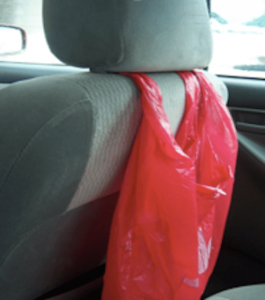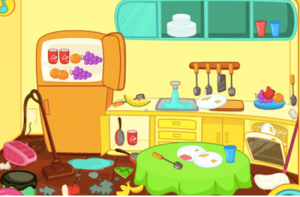Rhonda & I started Heart of the Matter Professional Organizing in June 2004. This week, and again next week, I’m going to share some of our all time favourite tips. Our team uses these strategies in our own homes and have implemented them in the homes of 100’s of clients over the years.
Put them into place and you will be well on your way to forming good habits that will help you get (and keep) your home and family in order.
Thanks for allowing us to be your success partners as you get to The Heart of the Matter!
TURN YOUR HOT SPOT INTO A HOTFILE
Most of us have at least one Hot Spot in our home. Where’s yours? On your kitchen counter or the corner of your dining room table? It is the spot where short term temporary paper accumulates in the homes of busy families.
The scary thing is that in that pile there can be things from one extreme to the other – junk mail on its way to recycling or a cheque for $300 that came in the mail that day. Perhaps your kitchen counter looks something like this….
Remember…….everything needs a home and that includes your short term/temporary paper.
Our suggestion is to turn your Hot Spot into a Hotfile.
Get yourself a file caddy. HOM sells our version as a kit. You can purchase the kit through us or put your own together.
In addition to your file caddy you’ll need hanging files, a couple of file folders and some file tabs.
Sit down with your Hot Spot and go through it. Give every category of paper a home in your newly created Hotfile.
Here are three must have categories to include when you create your Hotfile:
- Red Hot file – use a red file folder (within a hanging file) so it stands out. This is the “oh my gosh can’t forget about this” file. Discipline yourself to check your Red Hot File every day. If you don’t check it you won’t trust it, and if you don’t trust it you won’t put anything in it and the system will break down.
- To Read File – use a manila file folder (within a hanging file) so it is portable. This is the spot where you put the little bits that you’d like to read at some point, such as the school newsletter or inserts from your bills. Grab the To Read File and take it along when you’ll be waiting at the doctor’s office or for your kids at piano lessons. Catch up on your reading. Recycle when you are done and drop the folder back into place in your Hotfile.
- File for each member of the family
Here are some other categories that may make sense for your family:
- Committees/clubs that you are involved with
- A file for the week’s grocery flyers
- Items for income tax as they accumulate throughout the year
- Take out menus
- Items you are researching to purchase
- You get the idea – sit down with your Hot Spot and give everything a home in your Hotfile!
Once you have created your Hotfile, then follow these 3 simple Rules:
- Check your Red Hot File every day. Do it at the same time you take your vitamins or drink your morning coffee so it becomes a habit.
Remember…..if you don’t check it you won’t trust it, and if you don’t trust it you won’t use it!
- Store your Hotfile in prime real estate. It needs to be close to the action. We are basically lazy. Put it too far away and you’ll never use it.
- Set-up categories in the Hotfile that are appropriate for your family.
The Hot File is a great system that works for handling your short term/temporary paper!
THE ELASTIC TRICK
You know how you buy a large bag of flour and it doesn’t all fit in your flour container? Or you buy a bulk container of basil and it doesn’t all fit in your little spice container?
Try this!
- Open the new package and fill your container.
- If it doesn’t all fit in then put an elastic band around the container. This is a visual cue for you that you have more of that product stored elsewhere.
Place the remainder of the product in a bin marked product overflow and store it somewhere that is not in prime real estate. Perhaps on an upper shelf or in your pantry.
When the container with the elastic is empty, then go to your product overflow Grab the remainder of the package and re-fill your container. When the original package is empty, it is time to remove the elastic. No elastic on the container is a visual cue that you don’t have anymore in storage and need to put the item on your grocery list.
This works great for all kinds of items. We even use it for our different types of cooking oils. They are often in large jugs or tall bottles that are difficult to store in the kitchen. Put some in a smaller jar, and store the larger containers elsewhere. Don’t forget the elastics!!
ALL ROOMS NEED GARBAGE AND RECYCLING
By having garbage and recycling handy it sets the expectation for us and our family to put things in the appropriate spot rather than leaving them sitting around on their way to the garbage and recycling.
Walk around your home and have a look. What rooms are missing this critical piece. Often, the last room to come on board is our family room. It is so important in this area, because we spend so much time there.
Keep in mind that the containers you use don’t have to be the traditional garbage cans and blue boxes. In my office I use a nice wicker basket for my paper recycling and a brass planter for my garbage can. Be creative!
Another area where it is especially important to have recycling is in your computer area or home office. If you don’t have a receptacle there it is easy to create a recycling hot spot – a pile of paper on its way to recycling. It can easily get covered over with other paperwork and then a day or two later you’ll need to reacquaint yourself with what it is, only to find that it is the recycling that you meant to take care of a day or two earlier.
Always be sure to open your mail right beside the blue box. Then you won’t have to handle the recycling more than once.
Be sure to have a spot for your garbage in your vehicle too. Even if it is something as simple as a plastic garbage bag hanging over the head rest. Remember……everything needs a home, and that includes garbage and recycling!
PUT VALUE ON ROUTINES AND CHECKLISTS
- Do you have any tasks that you do over and over?
- Are there things at your work that you have to complete monthly?
- Are there routine tasks that you need to accomplish weekly at home?
Instead of relying on your memory and holding it in your head, why don’t you write it down or create a checklist on your computer?
If you need the checklist in front of you until it becomes routine, then print out the list, put it in a page protector and use a dry erase marker to check off each step as you accomplish it. This way you can use the same checklist over and over.
This is a great strategy for children. If you have a list of things they need to do in the morning to get ready for school, or a list of weekly chores, then make a checklist with either words for older children or pictures for those who can’t read. Then they can literally check off each task as they accomplish it. This sets you up for success on consequences as well. No more nagging. If children don’t do what is expected of them before or after school (by following the checklist) then it is reasonable for you to enforce consequences.
- Do you go to the same cottage each summer? Could you make a packing checklist and use it year after year?
- Do you send out Christmas cards to the same group of people each year? Why not make a template of everyone on your list?
- Should you come up with a checklist of everything you could do the night before instead of leaving everything to the last minute in the morning?
Brainstorm what sort of checklist templates you can create to help make daily life easier.
It is amazing how much comfort there is when we get everything down on paper! One less thing to keep in our head!
MAKE FRIENDS WITH YOUR TIMER
Are you like many of us and sometimes find it easy to procrastinate when there is a big job that you need to tackle?
Here is a strategy that you might want to try!
Make friends with your kitchen timer.
Often times a task seems huge because we think we need to work at it for a long period of time. The prospect of that is no fun, especially if it is something we don’t like to do.
A prime example for me is cleaning up my kitchen.
Sometimes it seems like such a huge job and I just can’t face it AGAIN, but if I set my timer for 15 minutes and work hard and fast it is amazing what I can do. When the timer goes off usually one of two things has happened. Either, I’ve accomplished what I need to do and I can move onto something else, or I’ve got over the biggest hurdle which is getting started. I can easily continue on with the job until it is completed, because I’m on a roll.
Making friends with your timer is helpful in lots of different situations.
- Maybe you have piles of filing and paperwork to catch up on and you are doing everything possible to avoid it. Set your timer and promise yourself that you only need to work at it for 15 minutes. Any of us can survive for 15 minutes.
- Maybe there are some jobs around the house that could be accomplished easily if the whole family helped out. Be sure everyone knows what their assigned tasks are. Set the timer for 30 or 60 minutes and go to it. If everyone works hard and fast it is amazing what you will accomplish as a team. At the end of the allotted time, reward yourselves with a walk to the park or a family movie night.
Make friends with your timer on a regular basis and you and your family can accomplish great things!
Put these tips into place and you will be well on your way to forming good habits that will help you get (and keep) your home and family in order.
If you, or someone you know, could use some hands on help in your space, contact us today!
Thanks for allowing us to be your success partners as you get to The Heart of the Matter!
FOOD FOR THOUGHT
I want to be like a caterpillar. Eat a lot, sleep for a while and wake up beautiful!


